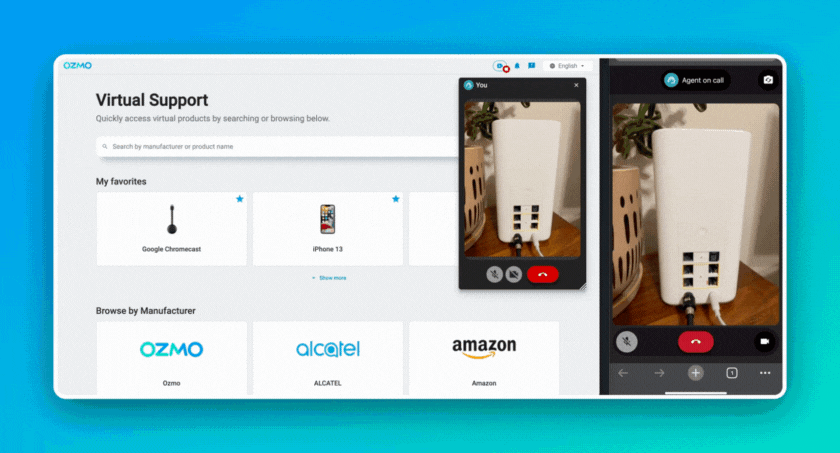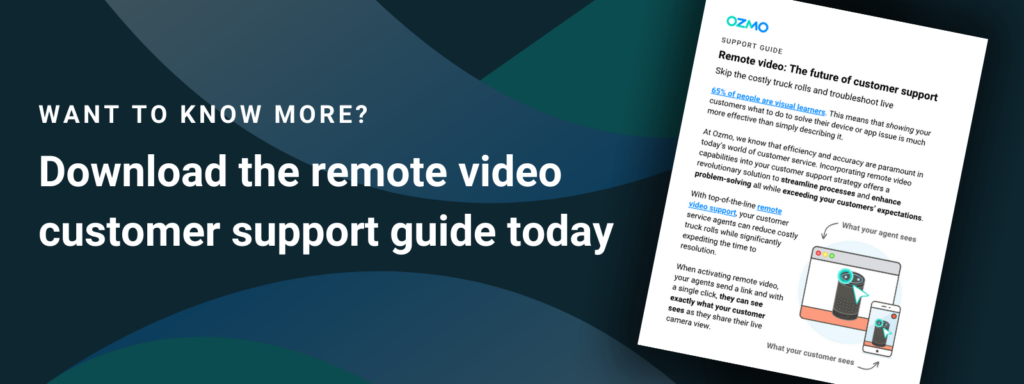These days, contact center leaders are expected to be magicians. They’re supposed to increase customer retention with less budget, declining customer patience and increased competition. So, how can contact centers address these operational challenges head-on?
Video chat customer support is the answer. Live video customer service offers numerous benefits for both telecom customers and businesses. From reducing truck rolls to increasing retention, visual support can be a key tool for differentiating your brand and ensuring your business's success.
However, it’s not enough to have a video chat tool in your tech stack. You need to ensure you’re using it effectively to have the most significant impact on the customer experience and contact center performance. Below, we go over five use cases for leveraging video chat customer support in your telecom business.
Video chat customer support: Five use cases
How can you ensure your business gets the most out of your visual support tools? Below, we go over five use cases for leveraging video support in your contact center.
Use case one: Slash truck roll costs with visual remote support
Truck rolls wreak havoc on your company’s budget. Research shows that businesses can pay up to $1,000 per truck roll. Additionally, one fourth of truck rolls require repeat visits - meaning your company could be paying up to $2,000 for a quarter of all dispatches.
So, how can you reduce truck rolls so they don’t take such a big bite out of your budget? Video support can be a critical tool for reducing costly truck rolls and improving the end-to-end customer experience. One of the key benefits of video chat is that agents can see exactly what the customer sees without dispatching a technician. This allows them to diagnose loose cables or router connection issues from home or the office.
As a result, your business can benefit from reduced avoidable truck rolls, resulting in significant cost savings. This, in turn, can create a better telecom customer experience. Customers don’t have to wait for a technician to drive out to diagnose the problem. They can get an immediate diagnosis and step-by-step troubleshooting, leading to faster issue resolution. This, in turn, creates a better customer experience, which can help improve your customer retention rate.
Use case two: Scale self-installation without sacrificing success rates
Deploying a team of professionals to install internet and TV services for customers is expensive. Yet self-serve installation can create significant customer frustration. 70% of customers will abandon the onboarding process if it takes longer than 20 minutes.
Friction in the onboarding process can lead to high customer churn rates, which can have a devastating impact on your company’s bottom line. Studies show it can cost up to seven times more to acquire new customers than to keep your current customer base.
It’s essential to create a strong relationship with customers from day one. Make sure you exceed their expectations and streamline the self-serve onboarding process as much as possible.
This is where video customer support can be a key differentiator for your business. Rather than leave customers to figure it out on their own with self-install kits, leverage video customer support to address customer retention from day one. Use video to provide personalized customer service and guide customers through the self-installation process. This approach can be critical for crafting a strong customer retention strategy that increases brand loyalty and positive sentiment about your business.

Use case three: Boost first call resolution with visual problem-solving
Your first call resolution rate (FCR) is critical for gauging the success of your call center. Yet, most telecom companies are struggling to achieve a good first call resolution rate, with an average of only 61%. This is lower than the average of 70% across industries.
Low FCR drives repeat calls, increasing call volume and average handle time (AHT). As a result, business expenses increase. Additionally, longer call wait times and multiple calls for issue resolution create a poor customer service experience.
So, what drives such a low FCR? Often, it comes down to communication issues. If a customer calls into your contact center because they’re having a problem with their router, the agent might ask where the router is located. The customer must then describe the router's location. This creates many opportunities for miscommunication, as people may describe things differently. It’s then up to the agent to imagine the router’s location.
With visual support, these missteps go away. The customer can show, not tell, the router's location. This makes it much easier for the agent to diagnose the problem. It also makes it easier for the agent to guide the customer through troubleshooting. Not only does video help the agent see the issue, but most video support tools allow the agent to draw right on the screen to show customers what to press and where. This streamlines the tech support experience for both agents and customers.
Use case four: Enable high-performing hybrid support teams
These days, most contact center agents aren’t working in an office five days a week. Nearly three-fourths of companies are implementing or planning to implement a hybrid customer service strategy.
Research shows that 83% of employees want a hybrid work arrangement. However, hybrid work models benefit both employers and employees. Research shows employers that who adopt a hybrid service model save an average of $11,000 per employee. Cisco reported that switching to a hybrid work model saved them $500 million, providing a powerful incentive for employers to consider more flexible work options.
However, it can be a challenge to ensure that employees working from home can deliver the quality tech support that your customers expect. So, how can you ensure that your team has the same tools as they would in the office? Again, this is where remote video support innovation can help. With video chat customer service, agents have the same visual access regardless of their location.
This helps you provide agents with the flexibility they need without sacrificing quality customer service. As a result, your company could not only benefit from reduced customer churn but also from improved employee engagement and lower agent turnover.
Use case five: Reduce churn with proactive video support
Use video support to differentiate your brand by flipping from a reactive to a proactive customer service model. Proactive customer service means addressing issues before customers are aware of a problem. In this advanced use case, you can use this approach to build relationships and uncover retention opportunities.
For example, you can use video customer service to conduct scheduled equipment health checks for customers. This can lead to improved retention through proactive engagement. Getting ahead of any critical service issues is vital for your retention efforts. 96% of customers will churn after just one bad service experience. By proactively addressing service disruptions or equipment issues, companies can streamline the customer experience and improve net promoter score (NPS).
Proactive support can also help your contact center team tap into new revenue opportunities. 88% of customers say they’re likely to make repeat purchases with companies that provide good quality customer support. This means that visual support and high-quality tech support, more generally, can transform your call center into a revenue driver.
Why early adopters are winning with video support
There’s no doubt that live video support is the future of customer service. Telecom companies can use live video support to improve their customer service in a variety of ways, from reducing truck rolls to tapping into new revenue opportunities. By considering the use cases demonstrated here, you can ensure you’re getting the most out of your video support tools to improve customer retention and improve key contact center metrics for your business.
Are you looking to learn more about leveraging live video support in your telecom business? Our free remote video support guide dives into how you can use visual support to provide personalized customer service and faster issue resolution. Download your free copy today.




